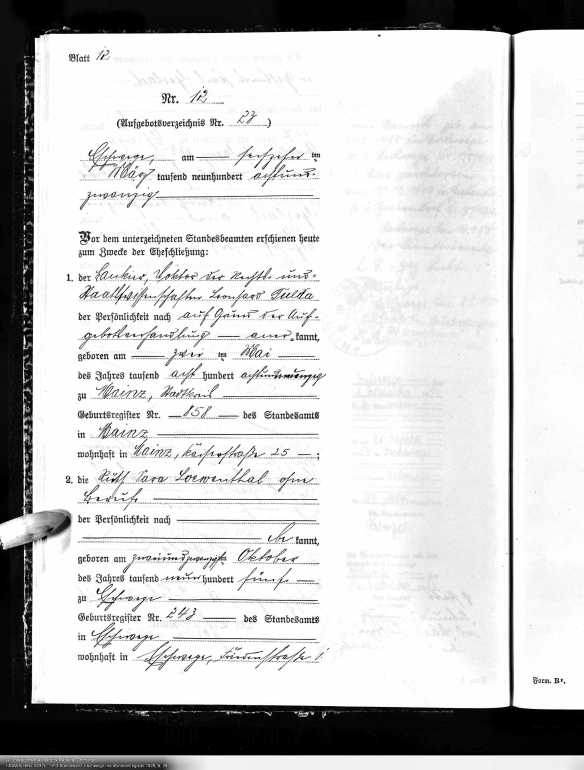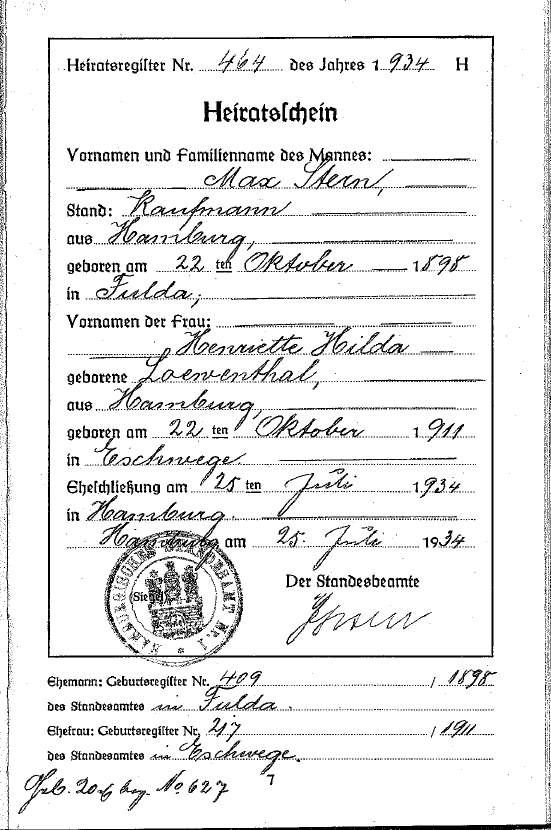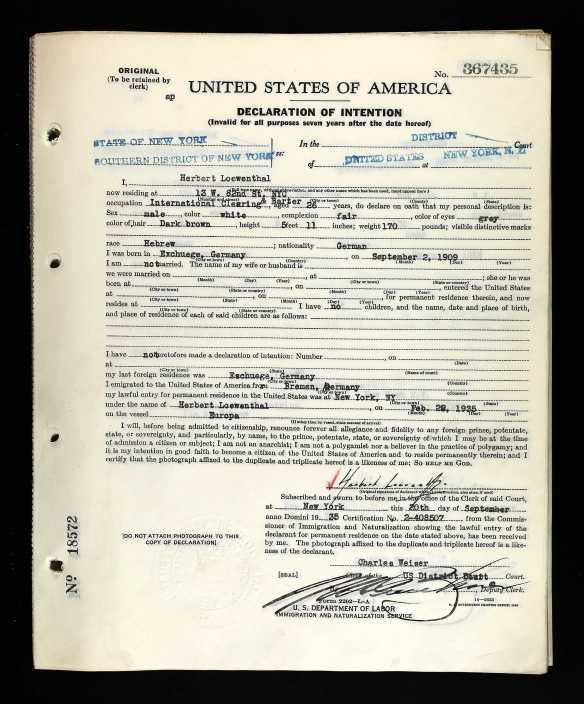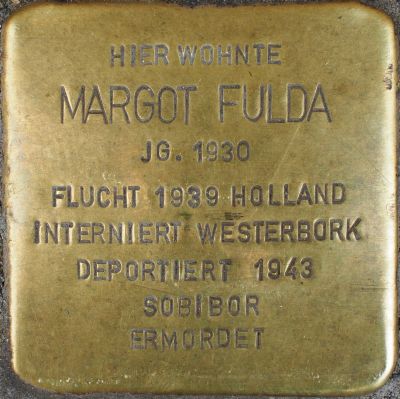Although the story of Selma Loewenthal Schwabacher’s family had happy endings in that the entire family safely left Germany and made new lives for themselves in the US, the story of Selma’s brother Julius is more complicated and more heartbreaking.
Julius Loewenthal and his wife Elsa Werner had four children, as we have seen: Ruth, born in 1905, Herbert, born in 1907, Hilda, born in 1911, and Karl Werner Loewenthal, born in 1918. Ruth had married Leonhard Fulda on March 16, 1928, in Eschwege, where her family lived.

Marriage Record of Ruth Loewenthal and Leonhard Fulda, Hessisches Hauptstaatsarchiv; Wiesbaden, Deutschland; Bestand: 923; Laufende Nummer: 1913
Ancestry.com. Hesse, Germany, Marriages, 1849-1930
On September 21, 1930, Ruth gave birth to their daughter, Margot Fulda, in Mainz, Germany.1
That happy event was followed by the marriage of Julius and Elsa’s younger daughter Hilda Loewenthal to Max Stern on July 25, 1934, in Hamburg.

Hilda Loewenthal and Max Stern marriage record (found in a biography of Max Stern posted on Ancestry)
Max Stern was born in Fulda, Germany, on October 22, 1898, to Emanuel and Caroline Stern,2 and had immigrated to the United States in 1926.3 He brought with him a shipment of five thousand singing canaries he’d accepted as repayment for a debt4 and started a bird store, as seen on the 1930 census. That business eventually grew into the highly successful pet and pet food company, Hartz Mountain Corporation.
Max had returned to Germany to marry Hilda Loewenthal, and then he and his bride returned to New York in August 1934.5 They visited Germany in 1935,6 but returned to New York, where their three children were thereafter born.

Max Stern, 1930 US census, Census Place: Manhattan, New York, New York; Page: 9A; Enumeration District: 0270; FHL microfilm: 2341293, Ancestry.com. 1930 United States Federal Census
Meanwhile, during these years, Hitler had taken power in Germany, and the Nazi persecution of the Jews had begun by the time Hilda and Max married in 1934. Herbert Loewenthal, Julius and Elsa’s second child and older son, left Germany and arrived in New York on February 22, 1935, with the intention of remaining permanently. He filed a declaration of intention to become a citizen on September 20, 1935, describing his occupation as international clearing and barter.

Herbert Loewenthal, Declaration of Intention, The National Archives at Philadelphia; Philadelphia, Pennsylvania; NAI Title: Declarations of Intention for Citizenship, 1/19/1842 – 10/29/1959; NAI Number: 4713410; Record Group Title: Records of District Courts of the United States, 1685-2009; Record Group Number: 21, Description: (Roll 489) Declarations of Intention for Citizenship, 1842-1959 (No 367301-368300), Ancestry.com. New York, State and Federal Naturalization Records, 1794-1943
Julius and Elsa came to New York to visit their children in February, 1936, but only for sixty days, according to the ship manifest.7
To learn more details about what happened to the family of Julius Loewenthal thereafter, I was fortunate to find the award and decision of the Claims Resolution Tribunal (hereinafter referred to as the “Warner-Loewenthal Claims Resolution Tribunal Opinion”) issued in response to a claim filed in the Holocaust Victim Assets Litigation by Julius and Elsa’s youngest child Karl Werner Loewenthal, also known as Garry Warner-Loewenthal .
According to the official website for the Holocaust Victim Assets Litigation:
In 1996 and 1997, a series of class action lawsuits were filed in several United States federal courts against Swiss banks and other Swiss entities, alleging that financial institutions in Switzerland collaborated with and aided the Nazi Regime by knowingly retaining and concealing assets of Holocaust victims, and by accepting and laundering illegally obtained Nazi loot and profits of slave labor. All of the cases were consolidated in the United States District Court for the Eastern District of New York (“the Court”). ….
The lawsuits were filed because in the decades after the Holocaust, Swiss financial institutions had failed to return deposits to the Nazi victims (or their relatives) who had entrusted their assets to the banks. Although the issue of these bank accounts had been raised many times during the decades after the Holocaust, in the late 1990s, the banks’ behavior came under scrutiny of a type that Switzerland had not experienced before.
The litigation was settled in 2000, and a special master was appointed to establish a process for distributing compensation to claimants. Garry Warner-Loewenthal filed a claim for the account of his father, and the tribunal’s full decision on his claim can be found here. It details the facts alleged by Julius’ son in support of his claim, for which he was awarded 47,400 Swiss francs.
According to the Warner-Loewenthal Claims Resolution Tribunal Opinion, Herbert Loewenthal moved from the US to Zurich, Switzerland before 1937. Ruth Loewenthal and her husband Leonhard Fulda were planning to move to the US and in the fall of 1937, they went to visit Ruth’s brother Herbert in Switzerland before immigrating, accompanied by Ruth and Herbert’s father Julius Loewenthal. Central to the claim was the allegation that Julius had deposited money in a Swiss bank while in Zurich.
Tragically, Ruth and Leonhard were killed in a terrible automobile accident on October 3, 1937, while returning to Germany from Switzerland. Julius was seriously injured, but survived. Ruth and Leonhard’s daughter Margot, orphaned at seven years old, went to live with her father’s parents, Isaak and Joanna Fulda in Mainz.
In November 1937, just a month after the accident that killed their daughter and son-in-law, Julius and Elsa again visited New York for a limited time but returned to Germany.8 I have to wonder whether at this point they wanted to immigrate, given what was happening in Germany. Perhaps they could not get a visa allowing them to stay permanently. According to information given to Warner-Loewenthal Claims Resolution Tribunal Opinion, after the Nazis confiscated Julius’ business, he and Elsa fled to the Netherlands in 1938 and then to London. Finally, in May 1939, they were able to immigrate permanently to the United States.9

Julius and Elsa Loewenthal, ship manifest from England to New York, Ancestry.com. UK and Ireland, Outward Passenger Lists, 1890-1960 . Original data: Board of Trade: Commercial and Statistical Department and successors: Outwards Passenger Lists. BT27. Records of the Commercial, Companies, Labour, Railways and Statistics Departments. Records of the Board of Trade and of successor and related bodies. The National Archives, Kew, Richmond, Surrey, England.
By the time the 1940 census was enumerated, Julius and Elsa were living in Kew Gardens, Queens, New York. Neither listed an occupation.10 Their daughter Hilda and her family were living in Manhattan, and Max Stern listed his occupation as a bird food merchant.11
Julius and Elsa’s youngest child Karl had fled to England in 1938, according to the Warner-Loewenthal Claims Resolution Tribunal Opinion. In November, 1939, Karl was found exempt from being interned as an enemy alien. He was working as a trainee in a hosiery factory in Leicester.

The National Archives; Kew, London, England; HO 396 WW2 Internees (Aliens) Index Cards 1939-1947; Reference Number: HO 396/56, 056: Internees at Liberty in UK 1939-1942: Lir-Lov
Ancestry.com. UK, WWII Alien Internees, 1939-1945
During the war Karl joined the British Armed Forces and was advised to change his name to Garry Charles Warner “for his own protection.” When he immigrated to the United States after the war in August, 1946, he added “Loewenthal” back to his name and was known as Garry Charles Warner-Loewenthal, as described in the Warner-Loewenthal Claims Resolution Tribunal Opinion.
It might seem that Julius Loewenthal’s family was relatively fortunate as Julius, Elsa, Hilda and her husband Max Stern, Herbert, and Karl/Garry all survived the Holocaust and the war. Ruth and her husband Leonhard Fulda were killed, but not by the Nazis; they died in a car accident. Of course, Ruth and Leonhard might never have been involved in an accident if they hadn’t gone to Switzerland to visit Herbert, who had been forced to leave Germany because of the Nazis.
But that is not the end of the story. Recall that Ruth and Leonhard’s daughter Margot had gone to live with her paternal grandparents, the Fuldas, in Mainz after losing her parents in October 1937. The Fulda family—Isaac and Johanna, their son Ernst and his wife Emma, and Margot, Ruth and Leonhard’s orphaned daughter—all escaped to Amsterdam in 1939. But they were ultimately deported from there to Sobibor, where every single one of them was murdered by the Nazis in 1943, including little Margot, who was not yet thirteen years old.12

Stolpersteine for Margot Fulda, Martin Steinmetz / CC BY-SA (https://creativecommons.org/licenses/by-sa/4.0) at https://upload.wikimedia.org/wikipedia/commons/c/c9/Fulda_Margot.jpg
Julius Loewenthal had survived a terrible car accident that caused him serious harm, the deaths of his daughter Ruth and her husband Leonhard in that accident, the confiscation of his business, the loss of his homeland, the escape first to the Netherlands, then England, and finally to the US, and, worst of all, the murder of his granddaughter Margot. Having survived all that, he died not long after the war ended on November 20, 1946, at the age of 72.13
Four years later, his daughter Hilda divorced Max Stern. She would marry again, but that marriage also did not last.14 Her mother Elsa Werner Loewenthal died in 1961 in New York at the age of 77,15 and then her brother Herbert died in Zurich in 1962; he was only 53 and had never married.16 Hilda Loewenthal Stern Duschinsky died on July 29, 1980; she was 68 and was survived by her children and grandchildren.17
That left only Garry Charles Warner-Loewenthal, born Karl Werner Loewenthal. He had married after the war and had one child.18 I could not find much other information about Garry, but we do know that just a few years before he died when he was already in his eighties, he filed a claim in the Holocaust Victim Assets Litigation and received some compensation for all that his family had lost. Garry died at the age of 87 in West Palm Beach, Florida, on March 1, 2005.19
The story of the family of Julius Loewenthal serves as a painful reminder that even those who survived the Holocaust suffered greatly and lived with those scars forever after.
-
German Federal Archives Residents’ List Annotations:Für tot erklärt.,
1939 Census ID Number(s):VZ392415, German Federal Archive ID Number: 871897, found at https://tinyurl.com/vb6ntsu ↩ - Birth record of Max Stern, Familien- und Geburtsregister der Juden von Fulda 1748-1899 (HHStAW Abt. 365 Nr. 345)AutorHessisches Hauptstaatsarchiv, Wiesbaden, p. 202. ↩
- Staats Archiv Bremen; Bremen, Germany; Bremen Passenger Lists; Archive Number: AIII15-18.08.1926-2_N, Ancestry.com. Web: Bremen, Germany, Passenger Lists Index, 1907-1939 ↩
-
“Max Stern, Founder of Hartz Mountain,” The Herald-News
Passaic, New Jersey, 21 May 1982, Fri • Page 31 ↩ - Max and Hilda Stern, ship manifest, Year: 1934; Arrival: New York, New York; Microfilm Serial: T715, 1897-1957; Microfilm Roll: Roll 5526; Line: 1; Page Number: 118, Ancestry.com. New York, Passenger and Crew Lists (including Castle Garden and Ellis Island) ↩
-
Max and Hilda Stern, ship manifest, Year: 1935; Arrival: New York, New York; Microfilm Serial: T715, 1897-1957; Microfilm Roll: Roll 5683; Line: 1; Page Number: 8,
Ancestry.com. New York, Passenger and Crew Lists (including Castle Garden and Ellis Island), 1820-1957 ↩ - Julius and Elsa Loewenthal, ship manifest, Year: 1936; Arrival: New York, New York; Microfilm Serial: T715, 1897-1957; Microfilm Roll: Roll 5769; Line: 1; Page Number: 4, Ancestry.com. New York, Passenger and Crew Lists (including Castle Garden and Ellis Island), 1820-1957 ↩
- Julius and Elsa Loewenthal, ship manifest, Year: 1937; Arrival: New York, New York; Microfilm Serial: T715, 1897-1957; Microfilm Roll: Roll 6081; Line: 25; Page Number: 48, Ancestry.com. New York, Passenger and Crew Lists (including Castle Garden and Ellis Island), 1820-1957 ↩
- Julius and Elsa Loewenthal, ship manifest, Year: 1939; Arrival: New York, New York; Microfilm Serial: T715, 1897-1957; Microfilm Roll: Roll 6328; Line: 1; Page Number: 6, Ancestry.com. New York, Passenger and Crew Lists (including Castle Garden and Ellis Island), 1820-1957 ↩
- Julius and Elsa Loewenthal, 1940 US census, Census Place: New York, Queens, New York; Roll: m-t0627-02746; Page: 2B; Enumeration District: 41-1374B, Ancestry.com. 1940 United States Federal Census ↩
- Max and Hilda Stern and family, 1940 US census, Census Place: New York, New York, New York; Roll: m-t0627-02642; Page: 4B; Enumeration District: 31-774, Ancestry.com. 1940 United States Federal Census ↩
-
German Federal Archives Residents’ List Annotations:Für tot erklärt.
1939 Census ID Number(s):VZ392415, German Federal Archive ID Number: 871897 at https://tinyurl.com/vb6ntsu Also, see the entries at Yad Vashem, https://tinyurl.com/ts3xacc ↩ - Certificate Number: 9313, Ancestry.com. New York, New York, Extracted Death Index, 1862-1948 ↩
- Divorce Date: Mar 1950, County: Elmore, Ancestry.com. Alabama Divorce Index, 1950-1959. Original data: Alabama Center for Health Statistics. Alabama Divorce Index, 1950-1959. Montgomery, AL, USA: Alabama Center for Health Statistics. Marriage of Hilda Stern to Eugene Duschinsky, License Number: 609, New York City Municipal Archives; New York, New York; Borough: Manhattan, Ancestry.com. New York, New York, Marriage License Indexes, 1907-2018 ↩
-
Death Date: 22 Mar 1961, Death Place: Queens, New York, New York, USA
Certificate Number: 3535, Ancestry.com. New York, New York, Death Index, 1949-1965 ↩ - See Warner-Loewenthal Claims Resolution Tribunal Opinion ↩
- Social Security Number: 057-38-8878, Birth Date: 22 Oct 1911, Death Date: Jul 1980, Social Security Administration; Washington D.C., USA; Social Security Death Index, Master File, Ancestry.com. U.S., Social Security Death Index, 1935-2014 ↩
- License Number: 650, New York City Municipal Archives; New York, New York; Borough: Queens, Ancestry.com. New York, New York, Marriage License Indexes, 1907-2018 ↩
- Death Date: 1 Mar 2005, SSN: 056244639, Ancestry.com. U.S., Social Security Applications and Claims Index, 1936-2007 ↩

I remember the news about the collaboration of the Swiss banks with the Nazis which came to the light more than thirty years ago. I was puzzled about the fact that institutions as impeccable as the Swiss banks can make such shady deals.
The ‘Stolpersteine’ (tripping stones) have inserted into the sidewalks of many German sidewalks to remind people of the holocaust victims who once lived there and were murdered by the Nazis. It is truly tragic that Margot’s family did not decide to escape to England, perhaps thinking it was safe to remain in Amsterdam.
LikeLiked by 1 person
Yes, I hadn’t known about the Swiss collaboration until I researched this post, and I was also surprised. War and fear bring out the worst in us, I’m afraid.
We have seen Stolpersteine in so many places in Europe. Each one tears at our hearts, especially when it is one for a child as young as Margot. It’s hard to know why some chose to go to the Netherlands, not England or the US or Palestine. I know that the US began refusing refugees. Perhaps England did also?
Thanks for your thoughts, Peter!
LikeLike
Here is a copy of a news clip, which shows that Canada also became guilty by refusing to accept Jewish refugees fleeing their Nazi oppressors:
Nov. 7, 2018, 3:00 PM PST
By Associated Press
TORONTO — Canadian Prime Minister Justin Trudeau formally apologized Wednesday on behalf of his nation for turning away a ship full of Jewish refugees trying to flee Nazi Germany in 1939.
The German liner MS St. Louis was carrying 907 German Jews fleeing Nazi persecution and it also had been rejected by Cuba and the United States. The passengers were forced to return to Europe and more than 250 later died in the Holocaust.
Trudeau called the apology long overdue.
Hitler “watched on as we refused their visas, ignored their letters and denied them entry,” Trudeau said in Parliament.
“There is little doubt that our silence permitted the Nazis to come up with their own, ‘final solution’ to the so-called Jewish problem.”
He said lawmakers at the time used Canadian laws to mask anti-Semitism.
LikeLiked by 1 person
Thank you so much for sharing this, Peter. It’s so painful to read these things and realize how many lives could have been saved but for the fear and selfishness of so many countries. I hadn’t known about Canada either. And yet—here we are today in the US and in so many other places, turning away refugees because of fear and prejudice and selfishness.
LikeLiked by 1 person
It was so sad to read Margot, after being orphaned, was able to escape Germany but then deported and killed by the Nazis. It reads like a novel with all the ups and downs but the author can’t give us the happy end we’d wish for.
LikeLiked by 1 person
How I wish I could have. I wish I could for all of the millions killed by the Nazis.
LikeLiked by 1 person
I know it breaks your heart, Amy. Hugs.
LikeLiked by 1 person
Reading along, I was of course saddened to read of the car accident deaths and then, pow, Margot and the Fulda family reveal of their murder….so tragic 😦 I started thinking about your last statement in the post ‘that those who survived suffered greatly … ‘ reminding me of a girlfriend who is the only child of 2 surviving parents of the Holocaust. Their scars greatly affected her life (my friend) as well. Well told posting and always providing me a moment to stop and reflect.
LikeLiked by 1 person
I think the scars of the Holocaust are carried by the generations that follow the survivors. One book I read recently that moved me on many levels was The Survivors by Adam Frankel. I highly recommend it. It’s not really just a Holocaust story but also a DNA mystery.
LikeLike
Thank you – I’ll be looking for that book 🙂
LikeLiked by 1 person
I think you will really find it fascinating.
LikeLike
The Swiss were not as neutral as they claimed. I remember the trials as well. My brother worked for a Swiss company and traveled there often. True story, during this time he went to a board meeting. The CEO of the campanula apologized to my brother about these trials and what they had found out. That they were not alive then but felt they needed to apologize to someone whose family was impacted by the Shoah.
LikeLiked by 1 person
Good for the CEO. I was not aware of the trials or the Swiss complicity. As I commented above, war and fear bring out the worst in us. Thanks for sharing that, Ellen.
LikeLike
Thank you again for sharing the story of your family’s journey through the Holocaust. These personal stories need to be told and understood. By bringing the story down to the individual it is easier can to comprehend the horror. For me, visiting the Anne Frank house made it personal. When I visited Dachau it was so horrifying that I could not truly comprehend what took place there. I was there in 1968 and at that time you could stand in the gas chamber and walk right up to the ovens. It seemed unreal, unfathomable. I knew thousands had died there but it was very hard to accept it. Right now I can picture a 13 year old girl who suffered these horrors.
LikeLike
Thank you, Ted. You are right—the individual stories are so important. We visited the Anne Frank House in 2013, and I was weeping. At Yad Vashem I felt rather unmoved because the names and numbers were so overwhelming as to be unreal, as you said. When we went to Auschwitz and Terezin, on the other hand, I focused on the relatives who had died there, and that brought it back to a far more personal level. That’s why Holocaust literature and memoirs are so important.
LikeLike
Oh, what a sad, tragic, horrible story. So sad. As soon as you said she went to live with them in Mainz, I thought, oh no!
So the surname Fulda was the same as a place name? Isn’t that what you said?
LikeLiked by 1 person
Yeah, that was some foreshadowing there, huh?
My guess is that someone in Leonhard Fulda’s family was from Fulda back in the early 1800s when Jews adopted surnames. Lots of those German surnames are in fact places names (Berliner and Frankfurter, for example).
LikeLiked by 1 person
Ah, ok, thank you for that info!
LikeLiked by 1 person
Pingback: Escaping from Germany, Part IV: Helene and Martha Loewenthal, An Unfinished Research Project | Brotmanblog: A Family Journey
I am the daughter of Garry! I live in Seattle and would love to share more information.
LikeLiked by 1 person
Hi Joanne! I’ve been trying to connect with you since before I posted that! I will try again. 🙂
LikeLike
Pingback: The Memoir of Julius Loewenthal, Part I: Growing Up in Frankfurt | Brotmanblog: A Family Journey
Pingback: The Memoir of Julius Loewenthal, Part IV: Tragedy Strikes | Brotmanblog: A Family Journey
Pingback: Helene Katzenstein Brinkmann Werner: Losing A Son in World War I | Brotmanblog: A Family Journey
Pingback: Henriette Werner Cohen and Her Children: Escaping from Germany | Brotmanblog: A Family Journey
Pingback: Moritz Werner And Family, Part III: After The War | Brotmanblog: A Family Journey